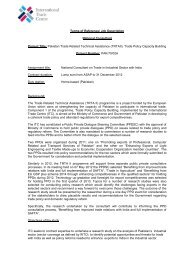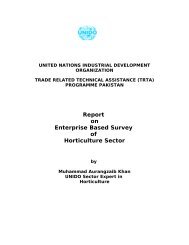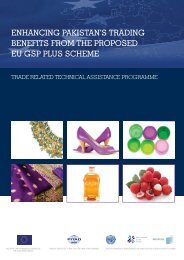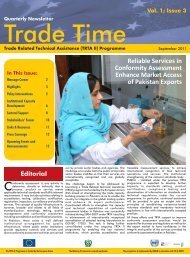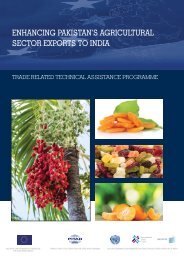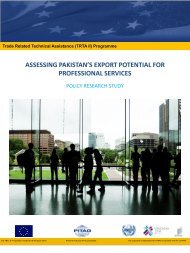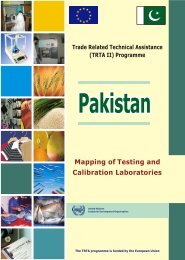Enhancing dairy sector export competitiveness - International Trade ...
Enhancing dairy sector export competitiveness - International Trade ...
Enhancing dairy sector export competitiveness - International Trade ...
Create successful ePaper yourself
Turn your PDF publications into a flip-book with our unique Google optimized e-Paper software.
ENHANCING DAIRY SECTOR EXPORT COMPETITIVENESS IN PAKISTANTable 14: Dairy Milk and Cream Powder Imports by Potential CountriesPotential Markets Supplying Countries in 2011PhilippinesNew Zealand, Australia, USA, Ireland, India.ThailandNew Zealand, Netherlands, USA, Finland, Ireland.BahrainSaudi Arabia, Turkey, Kuwait, UK, Netherland, India.Source: Author’s calculations based on UN COMTRADE statisticsFactors Affecting Export of Dairy ProductsSimilar to the supply side constraints, the <strong>export</strong> growth is also affected by a number of factors which aresummarized below.Historical FactorsAt the time of independence, most of the farm animals were either taken away by the evacuees orindiscriminately slaughtered by refugees to meet their immediate food requirements. This was followed byslaughtering of the dry animals that were initially brought to the urban centres for milking purpose and wereslaughtered after the end of lactation period [(Barki, et al. (2006)]. This created bigger challenge for thepolicy makers and required certain appropriate measures to increase draught power and milk production atthe same time.A number of initiatives were taken in the first five year plan (1955-60) for the development of <strong>dairy</strong> <strong>sector</strong>with an overall objective to achieve self-reliance in milk production through adopting modern health andsafety and production techniques. However the objectives could not be achieved due to weakimplementation mechanism and changing priorities of the government which in the subsequent years werefocussed more towards the crop <strong>sector</strong> development while the objective of enhancing milk productionremained an unattended priority. Therefore as of today, the objectives of having a modern and valueadded <strong>dairy</strong> industry with sufficient capacity to produce <strong>export</strong>able surplus has remained a challenge andan unaccomplished task.Generating SurplusAs evident from empirical and historical data and its analysis contained in the above section, generating<strong>export</strong>able surplus from the available supplies or through introduction of developmental initiatives hasalways remained a challenge. Heavy proportion of milk production is in the unorganized <strong>sector</strong> and that toois mainly with the subsistent farm community 55. Wastage of milk during transportation and calving, lowproductivity in majority of farm animals due to inherent weaknesses and inappropriate feed, lack of interestin majority of farmers’ community to adopt best breeding and milking practices, limited investment in thevalue added industry etc. are the main factors that restrict availability of <strong>export</strong>able supplies and thereforePakistan despite being one of big milk producers has not been able to enjoy benefits from its comparativeadvantage.Pakistan’s milch cattle yield is almost one fifth the European average. 56 The production of milk cansubstantially be enhanced through scientific feeding, breeding and marketing. Although the investors areinclined to enter into this segment but lack of information on modern farming methodologies and marketingchannels that would ensure disposal of their produce and let them earn good value for their money restrictsthem from taking instant decisions. For this, an institutional mechanism is required to be established tofacilitate potential investors and educate them on the farming methods and to also establish linkages withthe upstream industry. There is also need for the carrying out training of the farmers in modern feeding and55 Up to 43% of <strong>dairy</strong>ing households still operate under conditions of subsistence with herd size of one or two. Another 28% of thehouseholds operate under conditions of near subsistence [Barkiet al. (2004)] with herd size between three to four animals.56 Mid Term Imperative and Strategy for Pakistan, Final Report of the Panel of Economists, Planning Commission, Government ofPakistan (April, 2010)45



